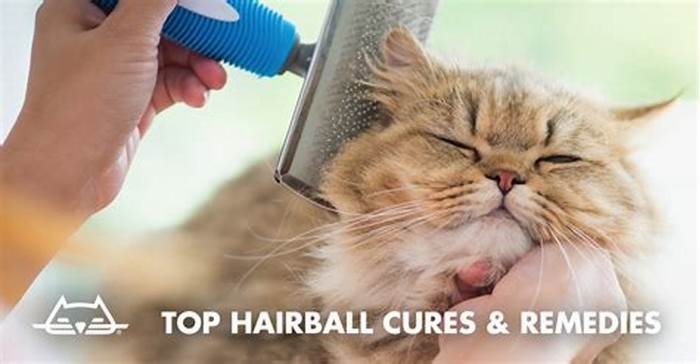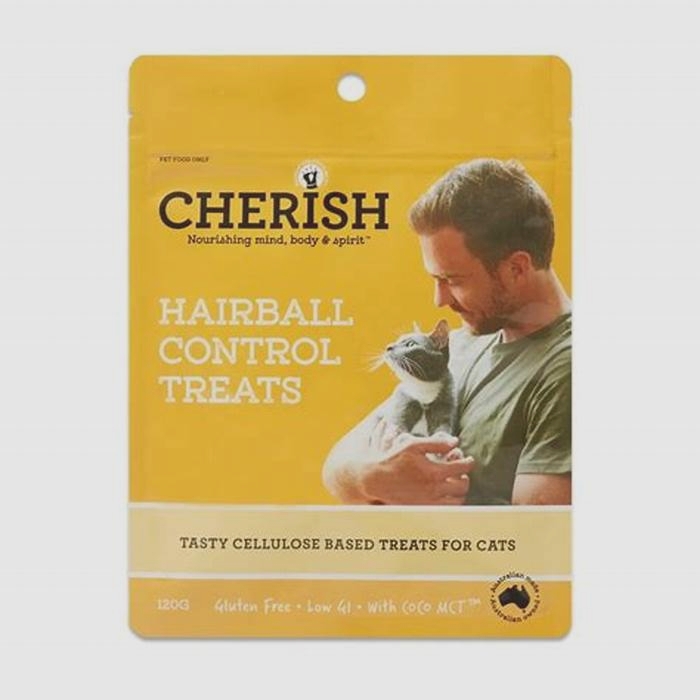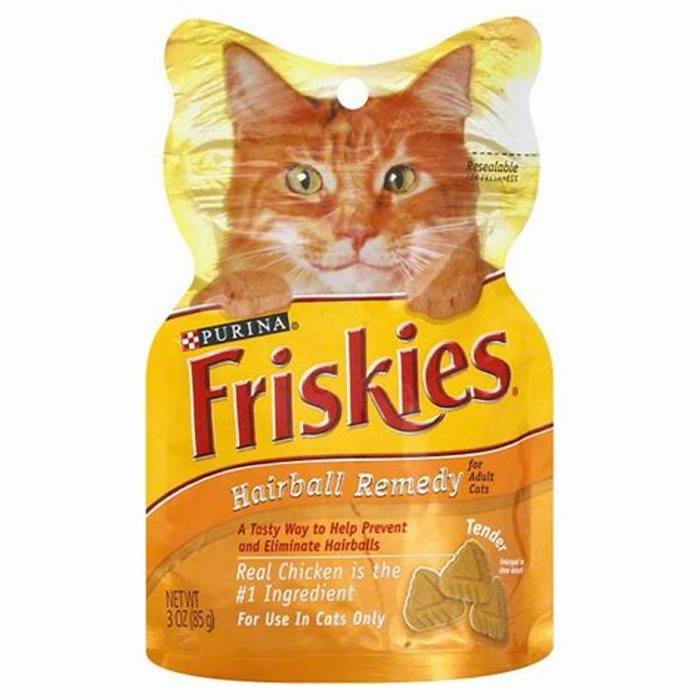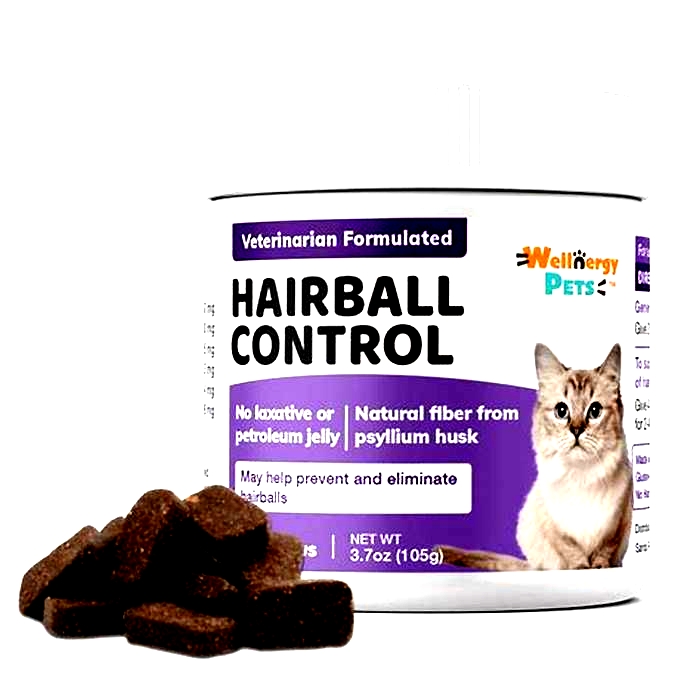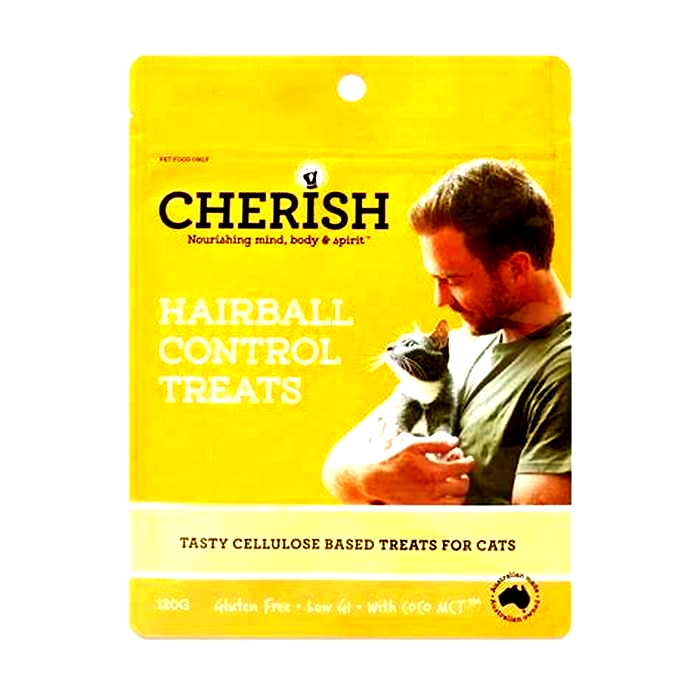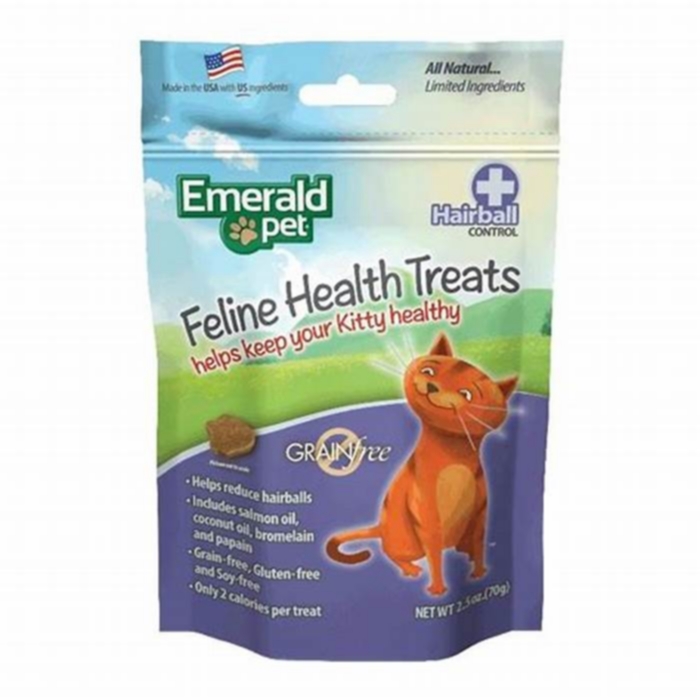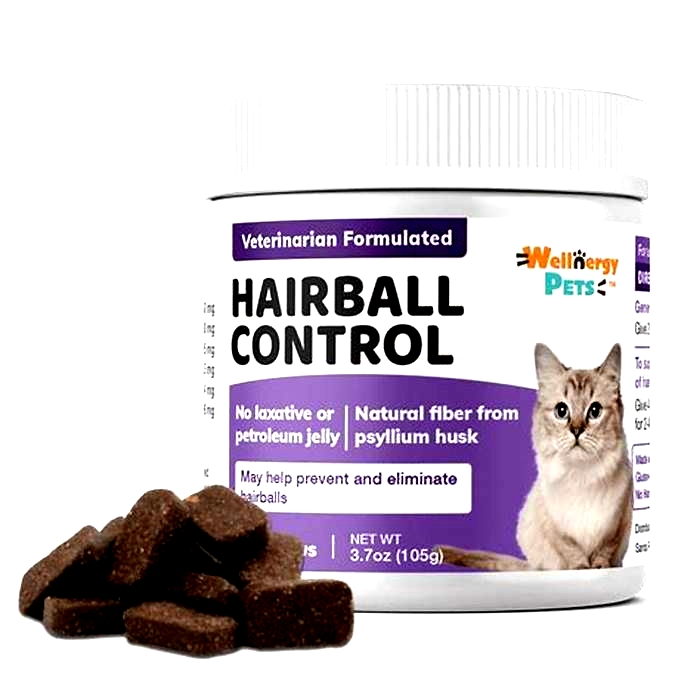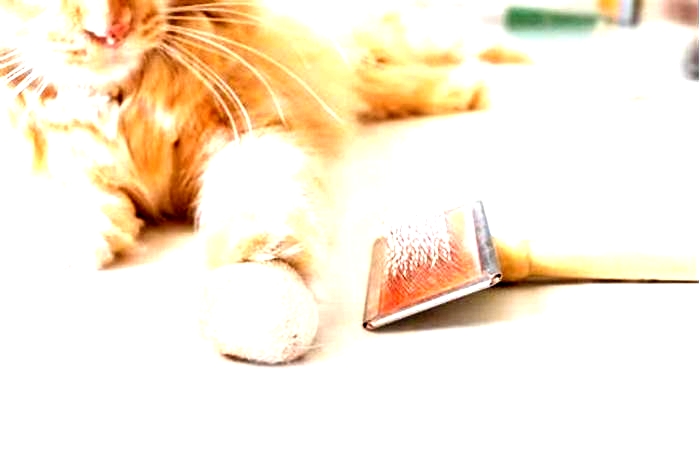No More Hairball Woes The Benefits of Hairball Control Treats
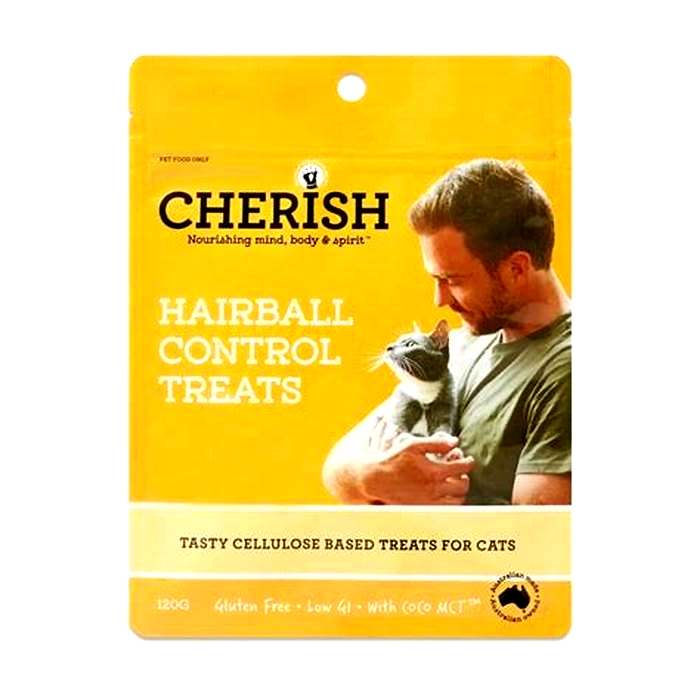
Cat Hairball Control
Your kitty is a cuddly little fur ball. And to keep him clean and cuddle-ready, his pretty coat requires both love and attention. He knows it and so do you. Like any vain kitty, he's got his cat grooming routine down to a science. He's very good at cleaning himself and, when not curled up taking a good nap, he spends many waking hours making sure his fur looks just right. But there are those times when kitty may need a little help. The constant licking and grooming can cause hairballs, which are an accumulation of hair in the digestive system, that result in kitty hurling or vomiting up a fur ball. For those moments, there are a few ways to step in and help him out a bit:Simply brushing your kitty using a cat brush like, the FURminator can help reduce the chances of fur build-up. Regular brushing diminishes shedding by up to 90%. This brush is designed to go deep beneath the topcoat and gently remove under coat and loose hair. There's also JW Pet Gripsoft Cat Comb which features a rubber sheathed handle so you can comfortably stroke and brush. Not only will this cat comb help prevent matting and formation of hairballs it's also a great way to bond with your kitty. Pair it with the Grip Soft Cat Slicker Brush for maximum effectiveness. There are also vitamin and supplements that are also useful in helping with this furry dilemma. Vets Best Hairball Relief Digestive Aid Cat Supplement is a veterinarian recommended formula packed with herbs like slippery elm bark, psyllium seed and marshmallow to provide natural hairball relief.There are fun tasty treats that can work wonders including Feline Greenies SmartBites Hairball Control Chicken Flavor Cat Treats. The best part is that you only have to give your furry friend a handful or two in his bowl and these yummy snacks begin to work their magic while he chomps away. Plus, they're not only made with real chicken protein, they also contain plant-based fiber that helps to minimize hairball formation and promote digestive health. Cat food blends that are specially made for hairball control may prove to be an ideal way to get a leg up on hairballs. Recipes like Blue Buffalo Indoor Hairball Chicken & Brown Rice Recipe Mature Dry Cat Food contain a unique blend of natural fiber sources to help control hairballs. And Iams ProActive Health Indoor Weight & Hairball Care Dry Cat Food contains natural fiber from oats to help avoid hairballs forming in the digestive tract and features fresh chicken is the first ingredient.Whether its cat food, treats or grooming products shop Chewy today for the best hairball treatments and hairball remedies around.
Related Categories: Cat Vitamins & Supplements, Vet Recommended Cat Diets, Cat Skin & Coat Care, Weight Loss Cat Food, Cat Hip and Joint Care, Cat Digestive and Urinary Health, Cat Anxiety & Stress Relief, Cat Eye Drops, Cat Ear Care, Cat Wound Care & First Aid, Cat Dewormer, Cat Test Kits, Cat Healthcare
What is the best cat hairball control treatment?
The best cat hairball control treatment will be easy to administer and effective for your cat. There are many cat hairball products to choose from, including cat hairball treats, cat food formulas for hairball control, and hairball remedies and supplements. Some people have success feeding their cats a hairball control diet, while others find they need to administer a hairball medicine like Laxatone to keep hairballs at bay. Hairball relief supplements and digestive aids can play an important role in hairball control, as well. Talk to your vet about good options for your cat and experiment to see which work best.
How do I stop my cat from getting hairballs?
Stop your cat from getting hairballs by talking to your vet about appropriate hairball care solutions. Some felines need little to no cat hairball help, while others may need a combination of interventions to avoid hairball issues. A hairball control diet combined with supplements or occasional cat hairball remedies as needed provides excellent control for many, but you may need to try a few things to find what works best for you.
Cat Hairballs 101: How to Help
Sharing your home with a cat has many upsideshairballs are not one of them. It might come as a surprise that hairballs are not an inevitable part of a cats life. Yes, cats do a lot of grooming and ingest a lot of fur in the process. But when all is well, that hair should pass uneventfully through their digestive tract and come out in the litter box.
Lets look at why that doesnt always happen and what you can do to treat and prevent hairballs in cats.
What Does a Cat Hairball Look Like?
In its most common form, a hairball looks like a wad of fur that has a somewhat tubular shape after being forced up through the esophagus. Fresh hairballs are usually wet, but they can dry out quickly if they go unnoticed. You may at first confuse a hairball with cat poop and think that your cat went outside their litter box.
Sometimes cat hairballs arent so well-formed. For example, you might come across a looser tangle of fur mixed with some food, mucus, or fluid, which may be tinged with bile. In these cases, it can be hard to figure out if your cat is vomiting because of the hair or if the hair was just brought up with everything else.
Image credit: Roo the cat
Why Is My Cat Getting Hairballs?
All cats swallow hair as they groom themselves, but why do some have problems with hairballs while others dont?
Fur is not digestible. Its made mostly of keratin, which isnt broken down by the acids and enzymes in a cats gastrointestinal (GI) tract. And when a lot of fur is in the tract, it tends to get tangled into large clumps.
A healthy feline digestive tract is designed to handle normal amounts of fur passing through, but two types of problems lead to the development of hairballs:
Ingestion of more fur than normal, which can happen with:
Diseases and issues affecting the GI tract:
What if My Cat Is Trying to Cough up a Hairball but Cant?
Most people say the phrase cough up a hairball, but whats actually happening is retching and vomiting. Sometimes retching can sound like coughing, but the hairball is in the cats digestive system, not their respiratory tract.
If youre nearby when your cat is trying to bring up a hairball, you might notice some telltale behaviors. Many cats cry out and get restless when they feel like theyre about to vomit. Then, your cats abdomen will contract several times and youll hear them retching with the contractions.
But sometimes the hairball doesnt come up on the first try or even the second, third, or fourth. You may hear the retching and see wet spots that look like clear or brown liquid where your cat tried to bring up the hairball as they move around from spot to spot.
Most people say the phrase cough up a hairball, but whats actually happening is retching and vomiting.
If they do succeed in vomiting up the hairball, they should seem to immediately feel better and go back to their normal behaviors. This is what sets hairballs apart from other cases of cat vomiting, which usually result in persistent nausea combined with other symptoms like lethargy and a poor appetite.
Call your veterinarian for advice if your cat tries to vomit two or three times in a day, whether they bring anything up or not, or if the vomiting continues for more than a day or two. You may be dealing with a hairball that has become stuck or you may not be dealing with a hairball at all.
Treating Hairballs in Cats
Cats that only bring up a hairball once a month or so generally dont need to be seen by a veterinarian for a thorough health workup. Trying a little home treatment makes sense.
But veterinary care is essential if your cat is having hairballs more often than this or if youre seeing other symptoms, like poor appetite, weight loss, vomiting, diarrhea, or constipation.
How Vets Diagnose and Treat Hairballs in Cats
The veterinarian will first ask questions about what youve seen at home and your cats health history, and then they will give your cat a physical exam.
Testing may include skin scrapings to look for mites, ringworm cultures, cytology to rule out skin infections, abdominal X-rays or ultrasound, blood work, urinalysis, fecal examinations, a hypoallergenic food trial, or biopsies of the gastrointestinal tract or skin. These tests will help the vet diagnose whatever is causing the hairballs.
If theres an underlying health or behavioral issue, the vet will recommend treatment to address it.
Home treatment is not appropriate for cats that have frequent hairballs.
Surgery is usually needed to remove very large hairballs that are blocking a cats GI tract. The doctor will examine your cats entire digestive system for other hairballs and repair or remove any damaged tissues that are found.
Are There Home Remedies for Cat Hairballs?
Home treatment is not appropriate for cats that have frequent hairballs. An underlying health problem is usually to blame for their formation, and if it isnt treated, the cat wont get better.
But for infrequent hairball episodes, here are several safe home remedies that you can try:
Never give your cat cooking oils, butter, lard, grease, or mineral oil in an attempt to help them with hairballs. Cooking oils and fats will merely be digested and wont help. Mineral oil is very dangerous if inhaled, which can easily happen when a cat is vomiting.
How To Prevent Cat Hairballs
Once your cat is hairball-free, you can start thinking about prevention. Underlying health problems may need continued management, but you can also try these tips:
- Brush your cat more often to reduce the hair they ingest. This is especially important for long-haired cats.
- Give your cat Laxatone or another hairball-control gel two or three times per week.
- Add fiber to your cats diet through treats and nutritional supplements or by switching to a hairball control food.
Together, you and your veterinarian can come up with the best way to treat and prevent hairballs. Your cat will thank you!
Featured image: iStock.com/krblokhin
WRITTEN BY
Jennifer Coates, DVMVeterinarian
Dr. Jennifer Coates is an accomplished veterinarian, writer, editor, and consultant with years of experience in the fields of veterinary...
The 5 Best Hairball Remedies For Cats
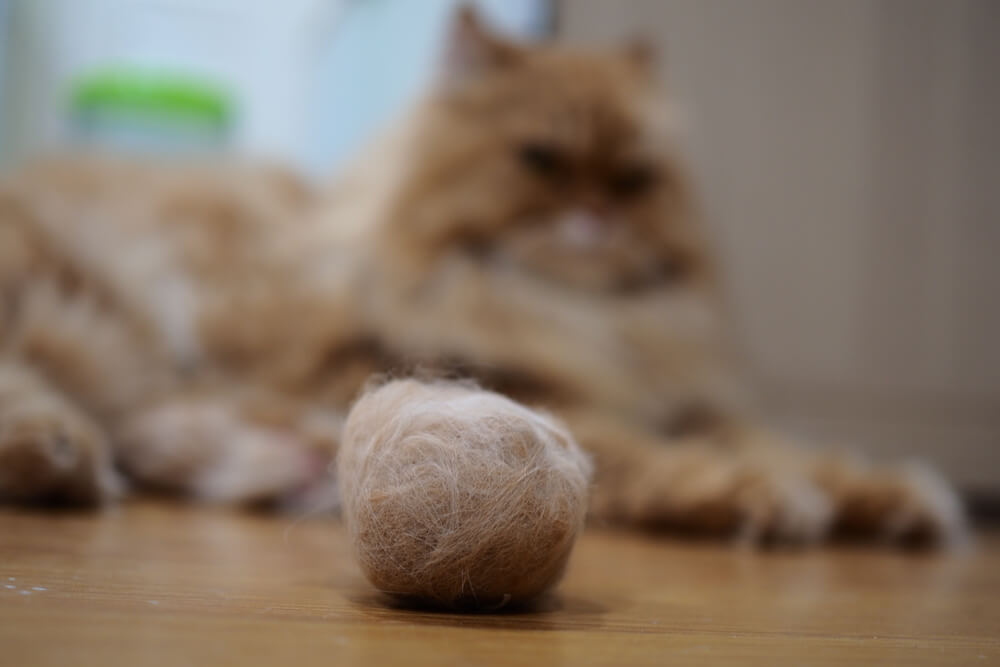
Note: Veterinary review of this article includes only the medical information in this article. The veterinarian reviewing this article does not personally endorse, recommend, or vouch for the efficacy or claims of any product mentioned in this article.
The best hairball remedies do more than help hair slide through your cats body. They treat the problem at its root by supporting overall digestive health.
Thats why we chose Cat Lax as the best hairball remedy on the market. This well known hairball gel contains a blend of ingredients that break up hairballs, prevent new ones from forming, and minimize shedding to keep hairballs at bay.
Before we learn more about Cat Lax and our other top five picks, lets talk about the types of hairball remedies and how they can help.
At a Glance: Our Top Picks for Best Hairball Remedies for Cats
Want a quick look at the products reviewed in this article? In the comparison table below, weve highlighted some of the most important features of each product. Youll find more detailed information about each product later in the article.
Overall Best
9.9
Picked by 31 people today!
- Contains a blend of lubricants
- Most cats like the gels flavor
- Affordable
Runner Up
9.8
Picked by 31 people today!
- Over 1,600 customer reviews, 4.5 star rating
- Cats seem to enjoy the tuna flavor
- Helps lubricate ingested hairs to prevent hairballs
BEST FOR BUDGET
9.6
Picked by 25 people today!
- Rich in omega-3 fatty acids
- Controls hairballs while supporting digestive health
- Most cats like the way the gel tastes
BEST HAIRBALL PREVENTION SUPPLEMENT
9.4
Picked by 21 people today!
- Most reviews are positive
- Made from a blend of well-regarded ingredients
- Appears to be safe for cats
BEST HAIRBALL CONTROL TREAT
9.3
Picked by 18 people today!
- Contains fiber to help move hair through the GI tract
- Features prebiotics and probiotics for digestive health
- Free of potentially-harmful ingredients
Types of Hairball Remedies for Cats
Hairballs form when hair gets stuck or slowed on its way through the digestive tract, allowing it to form into a clump. Once it forms into a clod, hair is unable to continue its journey to the litter box and instead it gets stuck or heads in the opposite direction.
Hairball treatments come in many different forms. You can buy hairball remedies in a tube, try homemade remedies, grow a pot of cat grass, or groom your cat to keep him from ingesting his hair at all.
Some cats with frequent hairballs may have an underlying problem like inflammatory bowel disease (IBD) that affects motility of their intestines, so diagnosing and treating this could solve their problems.
Heres a quick breakdown of the types of hairball remedies available and how they work.
Fiber
Fiber supplementation helps to bind single strands of hair to food particles, which carry the hairs on their journey towards the colon. By encouraging the hair to move quickly through the body, fiber-based hairball remedies reduce the hairs chances of fusing into a ball and coming back up.
Additionally, a small amount of dietary fiber can help keep the digestive system functioning smoothly, correcting hairball problems at their roots.
Fiber-Based Hairball Remedies
The following are sources of fiber that, when integrated into your cats diet, may help hair move smoothly through the body.
- Psyllium Husk Powder
- Ground Chia Seeds
- Guar Gum
- Powdered Cellulose
- Cat Grass
Lubrication
The second type of hairball remedies includes products that lubricate ingested hairs, preventing them from sticking together.
Petrolatum (Petroleum Jelly)
Petrolatum, also known as petroleum jelly, paraffin oil, or white petrolatum, is a highly refined derivative of petroleum. After its been fully refined, petroleum jelly appears to be safe for cats and people.
If you decide to give your cat petroleum jelly from your medicine cabinet, check the back of the package to ensure that youre giving your cat 100% plain petroleum jelly with no scents or other additives.
Hairball Gels
Most products marketed as hairball remedies are petroleum jelly-based. Others use vegetable oils or beeswax instead of petrolatum. They contain added flavors and sweeteners like malt syrup, fructose, and dextrose.
Butter and Oil
Butter and olive oil are frequently recommended for hairball control, but as digestible fats, theyre more likely to make your cat chubby than keep him from hacking up a furball.
Mineral oil had previously been recommended for hairballs, but it carries the risk of aspiration (going down into the lungs) since it doesnt trigger a cough reflex.
Other Hairball Remedies
Egg yolks have interesting properties for hairball control. They contain choline and lecithin, which work together to, respectively, encourage GI contractions and emulsify the fat that binds hairballs together.
You can provide the anti-hairball power of egg yolks by feeding your cat fresh egg yolks or by giving him an egg yolk lecithin supplement. A safe and effective dose for lecithin has not been established for cats, and most supplements formulated for people contain much more than is present in hairball products for cats.
Slippery elm bark contains soluble fiber, which may help to soothe and lubricate the digestive tract, reducing inflammation and helping the hairball move in the right direction
Dietary Changes
Though hairball-specific cat foods usually focus on fiber alone, this isnt always the right approach.
If your cat is already eating a diet with a little bit of fiber, the best dietary change is finding a food that reduces inflammation. Hairballs often indicate digestive problems and should be approached the same way youd approach any other symptom of gut inflammation, like diarrhea or vomiting.
Typically, this would mean giving your cat a high-protein food made primarily from meat and animal fat. You want as little plant matter as possible. A moisture-rich diet is ideal.
Read Our Article On The Best Cat Food For Hairball Control
Grooming
Finally, you can control hairballs by brushing your cat a couple of times a week. If your cat has a long, thick coat, you might also give him a full-body clip in the warmer months. Capturing loose hair before your cat licks it up is the most reliable means of stopping hairballs.
Read Our Guide To The Best Cat Grooming Brushes
Top 5 Best Hairball Remedies Reviewed
The following hairball remedies are popular, top-rated products that have a reputation for safety and effectiveness. Most are lubricating products, but youll also find a few that take a different approach to hairball control, addressing it as a component of digestive health.
Ultimately, you dont want to have your cat on lubricants and other hairball treatments for the rest of his life. You dont want him to have hairballs.
The above hairball remedies can help, but theyre not a complete solution to the hairball problem.
If your cat coughs up hairballs more than a few times a year, his frequent hacking is probably connected to digestive problems. In this case, he probably doesnt need to be swept out with fiber or lubricated with greasehe might need to go to the veterinarian. Extremely frequent hairballs may be a symptom of organ dysfunction, IBD, and other conditions.
If you determine that your cats hairballs are caused by a digestive issue, you may want to consider treating the hairballs the same way youd treat any chronic digestive problem.
Adjust your cats diet to reduce inflammatory ingredients and consider incorporating probiotics, prebiotics, and omega-3 fatty acids to promote digestive health
Also Read: Best Cat Food for IBD

